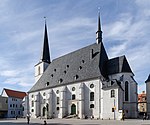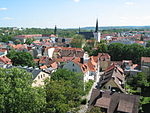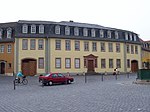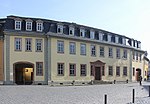Jacobsfriedhof

The Jacobsfriedhof, also known as the Jakobskirchhof ("St. James's Burial Ground" or "Churchyard"), is the oldest extant burial ground in Weimar, Thuringia, Germany, on land round the Jakobskirche (St. James's Church). The first burials took place here as early as the 12th century. The burial ground is located in the Jacobsvorstadt, which in the Middle Ages provided accommodation outside the city walls for pilgrims on their way to Santiago de Compostela (and today forms part of the historic Old Town under UNESCO protection). From 1530 to 1818 it was the only burial ground in Weimar. After 1818, when the "Neue Friedhof vor dem Frauentore" ("New Burial Ground before the Gate of Our Lady") was opened, now known as the Historical Cemetery, Weimar, many of the graves in the Jacobsfriedhof were levelled. From 1840 no more burials took place here, and the burial ground fell slowly into disrepair. Later the Weimar municipal authorities took it over and converted the burial ground into gardens. The Jacobsfriedhof today is part of the Klassik Stiftung Weimar.
Excerpt from the Wikipedia article Jacobsfriedhof (License: CC BY-SA 3.0, Authors, Images).Jacobsfriedhof
Am Jakobskirchhof,
Geographical coordinates (GPS) Address Nearby Places Show on map
Geographical coordinates (GPS)
| Latitude | Longitude |
|---|---|
| N 50.983333333333 ° | E 11.327777777778 ° |
Address
Jakobskirche
Am Jakobskirchhof 2
99423 , Jakobsvorstadt
Thuringia, Germany
Open on Google Maps











